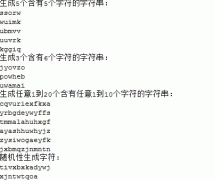Java语言的局部类
假如你有一个 Integer 对象的列表,并且你想使用 Coolections.sort 来对它们进行排序。另外,你还要自己指定一个比较器,因为你想按降序而不是升序排列它们。这里有一些代码示例说明了该怎么做:
import Java.util.*;
public class LocalDemo1 {
// 使用实现了 Comparator 的匿名类排序。
static void sortanon(List list) {
Collections.sort(list, new Comparator() {
public int compare(
Object o1, Object o2) {int cc = ((Integer)o1).compareTo(o2);return (cc < 0 ? 1 : cc > 0 ? -1 : 0);
}
});
}
// 使用实现了 Comparator 的局部类排序
static void sortlocal(List list) {class MyComparator implements Comparator {
public int compare(Object o1, Object o2) {int cc = ((Integer)o1).compareTo(o2);return (cc < 0 ? 1 : cc > 0 ? -1 : 0);
}};
Collections.sort(list, new MyComparator());
}
public static void main(String[] args) {
List list1 = new ArrayList();
list1.add(new Integer(1));
list1.add(new Integer(2));
list1.add(new Integer(3));
sortanon(list1);
System.out.println(list1);
List list2 = new ArrayList();
list2.add(new Integer(1));
list2.add(new Integer(2));
list2.add(new Integer(3));
sortlocal(list2);
System.out.println(list2);
}}
这段程序的输出如下:
[3, 2, 1]
[3, 2, 1]
上列中使用两种不同的方法实现了 Comparator 接口。第一种方法使用匿名类,第二种方法使用局部类,二者有何区别:一点区别是格式上的??匿名类的定义比较简捷,它实际上是下面这个表达式的一部分:
Comparator c = new Comparator() {...};
与之相反,局部类的定义看起来非常类似于常规的类定义,略为烦琐。例如,定义局部类内时可能用到 “implements”语句,而在匿名类中不需要显示的使用这条语句。
哪一种格式“更好”取决于你自己的观点。匿名类的定义会比较难读,但在不需要使用局部类的地方使用局部类会造成一些错觉,让人觉得需要做的事比实际要做的事更多。
让我们来看看另一个例子,更深层的比较匿名类和局部类:
import java.util.*;
public class LocalDemo2 {
// 使用两个单独的匿名类实例对两个列表进行排序
static void sort1(List list1, List list2) {
Collections.sort(list1, new Comparator() {
public int compare(Object o1, Object o2) {int cc = ((Integer)o1).compareTo(o2);
return (cc < 0 ? 1 : cc > 0 ? -1 : 0);
}
});
Collections.sort(list2, new Comparator() {public int compare(
Object o1, Object o2) {int cc = ((Integer)o1).compareTo(o2);return (cc < 0 ? 1 : cc > 0 ? -1 : 0);
}});
}
// 使用一个局部类的两个实例来对两个列表进行排序
static void sort2(List list1, List list2) {
class MyComparator implements Comparator {
public int compare(Object o1, Object o2) {int cc = ((Integer)o1).compareTo(o2);return (cc < 0 ? 1 : cc > 0 ? -1 : 0);
}}
Collections.sort(list1, new MyComparator());
Collections.sort(list2, new MyComparator());
}
// 使用一个匿名类的一个实例来对两个列表进行排序
static void sort3(List list1, List list2) {Comparator cmp = new Comparator() {
public int compare(Object o1, Object o2) {int cc = ((Integer)o1).compareTo(o2);return (cc < 0 ? 1 : cc > 0 ? -1 : 0);
}};
Collections.sort(list1, cmp);
Collections.sort(list2, cmp);
}
// 使用一个局部类的一个实例来对两个列表进行排序
static void sort4(List list1, List list2) {class MyComparator implements Comparator {
public int compare(Object o1, Object o2) {int cc = ((Integer)o1).compareTo(o2);return (cc < 0 ? 1 : cc > 0 ? -1 : 0);
}}
Comparator cmp = new MyComparator();
Collections.sort(list1, cmp);Collections.sort(list2, cmp);
}
static class AppComparator implements
Comparator {public int compare(Object o1, Object o2) {int cc = ((Integer)o1).compareTo(o2);return (cc < 0 ? 1 : cc > 0 ? -1 : 0);
}}
static Comparator appcomparator = new AppComparator();
// 使用应用程序中定义的比较器来对两个列表进行排序
static void sort5(List list1, List list2) {Collections.sort(list1, appcomparator);
Collections.sort(list2, appcomparator);
}
public static void main(String[] args) {
List list1 = new ArrayList();
list1.add(new Integer(1));
list1.add(new Integer(2));
list1.add(new Integer(3));
List list2 = new ArrayList();
list2.add(new Integer(4));
list2.add(new Integer(5));
list2.add(new Integer(6));
//sort1(list1, list2);
//sort2(list1, list2);
//sort3(list1, list2);
//sort4(list1, list2);
- 上一篇:Java对象序列化(1)
- 下一篇:用内嵌类减少JAVA程序设计中的混乱





